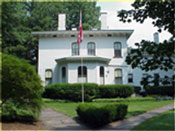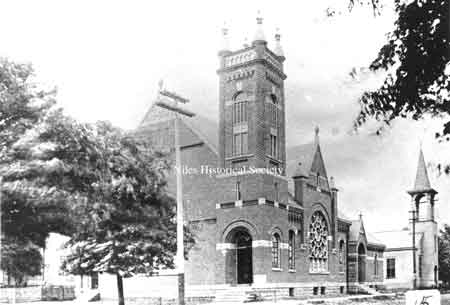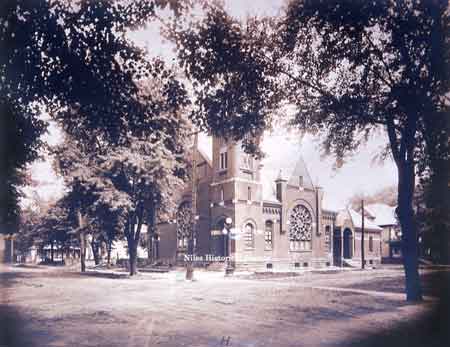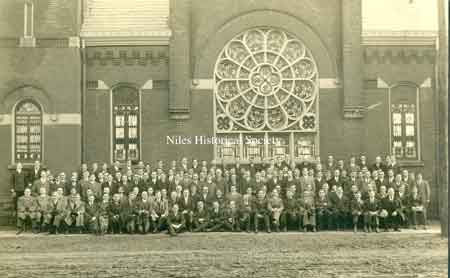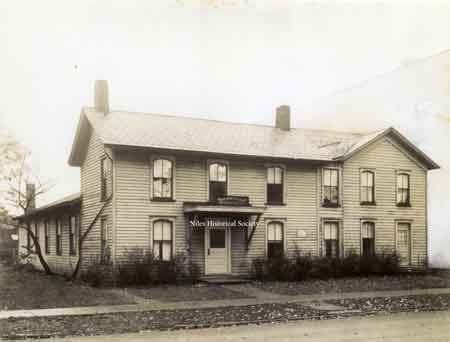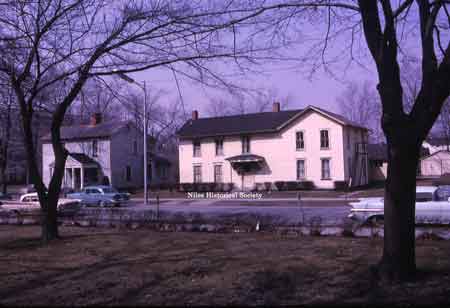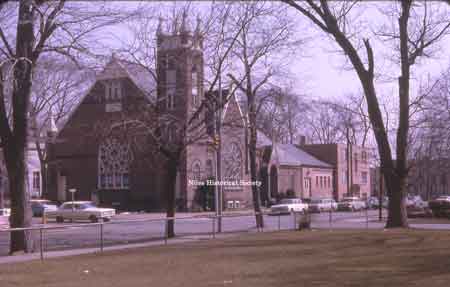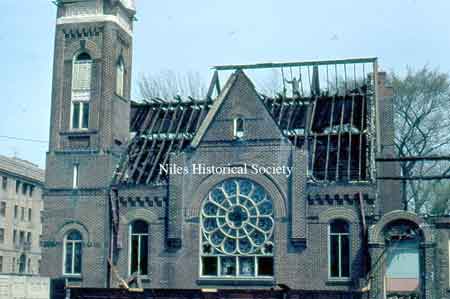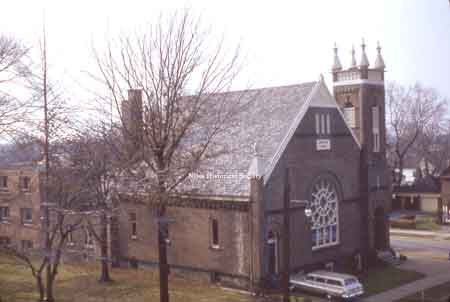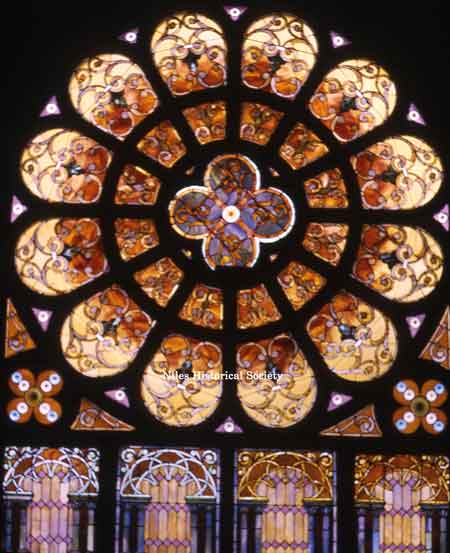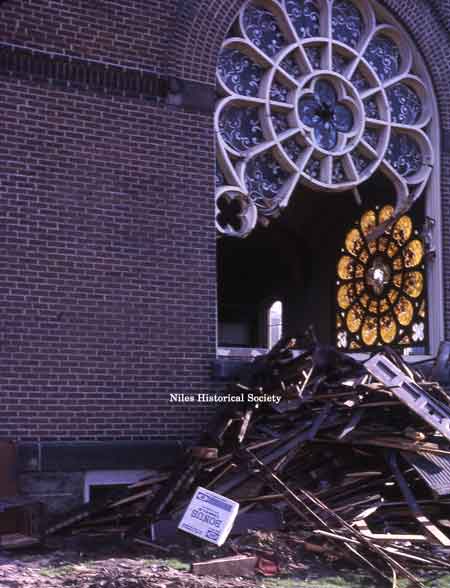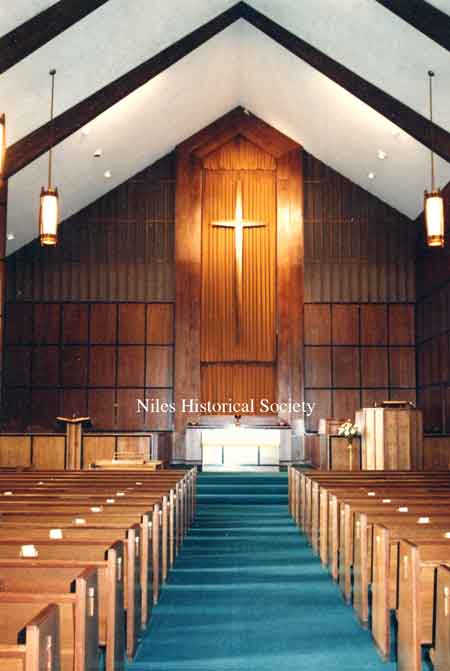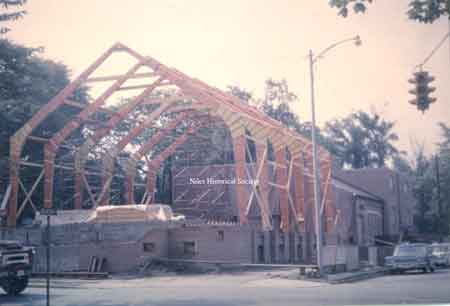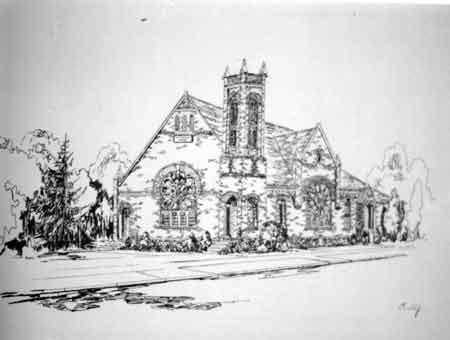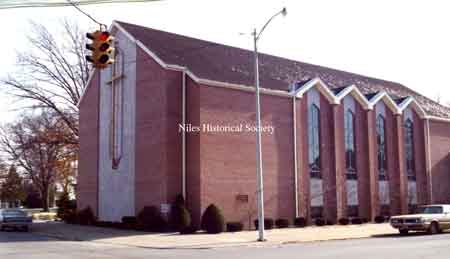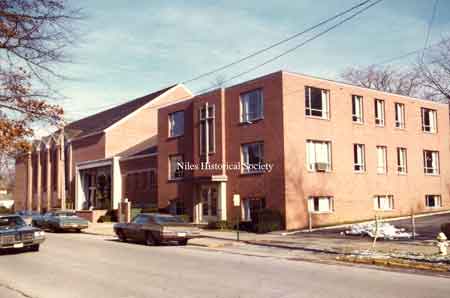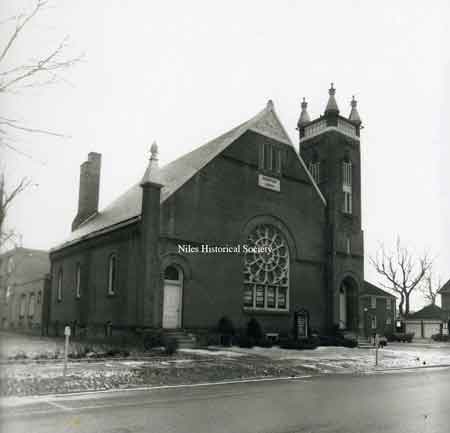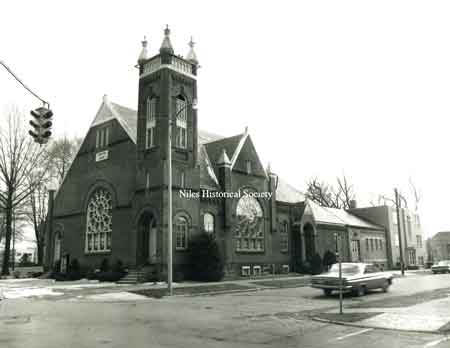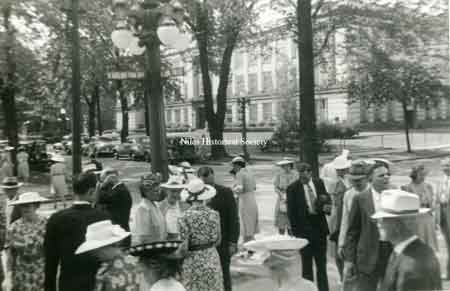Ward-Thomas Museum


The History of The First Christian Church of Niles.
Ward — Thomas
Museum
Home of the Niles Historical Society
503 Brown Street Niles, Ohio 44446
Click here to become a Niles Historical Society Member or to renew your membership
Click on any photograph to view a larger image, click on image again to zoom into photograph.
| The History of The First Christian Church of Niles. In the year 1840, after meeting about 3 years under the leadership of Elder John Henry, the group met in the brick schoolhouse on Leslie Ave and organized the Disciple Church of Niles. The group met there until 1844 when a frame building was erected on the lot where the present church now stands, at a cost of $1,800. The lot had been given to the church by James Heaton in 1843. The frame church is seen behind the brick church which was built in 1894. First Christian Church: P01.330 |
||
| |
||
| The
pulpit was in the south end of the church with a door on each
side of the pulpit, one for the men and one for the women. The
building was heated by a stove and lighted with candles. Some
time later the candles were replaced with oil lamps. This building
served the growing congregation until 1876 when it was remodeled.
The doors to the south were closed and a single entrance was placed
in the north end of the building on Church Street. In 1882 a belfry
was added. The bell from this structure was later installed on
the roof of the new educational building.
Evangelist meetings were held in open air tents holding over 4,000 and producing numerous conversions and baptisms at revival meetings. These meetings were an important part of the early church and people came from far away to hear the speakers. First Christian Church: SO1.333 |
||
| |
||
A new church was built at a cost of $12,500 and was dedicated on November 25, 1894. A pipe organ was installed at that time also. In 1899, a parsonage was built for $4,500 at the south end of where the educational building now stands. The Men’s Bible Class of First Christian Church on the lawn in front of the church. Men’s Bible Class: PO2.452 |
||
| |
||
| By 1918 the church had outgrown its Sunday School, so they purchased the property where the Parish House was located on Church Street. As time went on, the Parish house was repaired and remodeled several times. It had served nearly a century to the church and the community when it was razed in 1966. A photo of the Parish House of First Christian Church which was purchased in 1918 and razed in 1966. It sat on the northeast corner of Arlington and Church Streets where the Masonic Temple parking lot is located. |
||
|
S11.83.1 |
For 122 years the corner of Church and Arlington Streets had been the home of the First Christian Church. The stained glass window which faced Arlington Street was demolished when the new church was built in 1966.
|
|
| |
||
|
S11.83 L) View of the stained glass window facing Church Street. C) Interior view of one of the two First Christian Church stained glass rosettes that were on the north and west sides of the church. R) Exterior view of the stained glass window during the demolition of the church in 1966. |
S11.88.2 |
|
Left: A view of the interior of First Christian Church, built on the corner of Arlington and Church Streets. in 1966, on the site of an existing church. PO2.449 Middle: Exposure of the construction of the new building of First Christian Church located on the corner of Arlington and Church taken during the summer of 1966. PO2.448 |
Line drawing of the early First Chrisitan Church of Niles, Ohio situated on the corner of Arlington and Church Streets. It was torn down to make way for the new sanctuary in 1965. PO1.331 |
|
|
P01.335 |
A new church and the present day First Christian Church was dedicated in 1966 and the first service was held on Palm Sunday April 3, 1966. |
P01.33 |
|
PO1.332 |
Snapshot of the corner of Arlington and Church Streets on a Sunday morning as church was letting out at First Christian Church. The old Niles High school (Edison Jr.) is in the background. PO2.411 |
|
First
Christian Church Had Beginning Six Years After Founding of Niles
He preached in a little brick school house on Leslie Avenue, and there organized the Disciple Church of Niles in 1840. This church was a part of the religious body known as the Disciples of Christ, which came into being following the work of Alexander and Thomas Campbell in western Pennsylvania, West Virginia, Ohio, Kentucky, and bordering states, about 130 years ago. Third Church Here Heaton Donates Lot In 1844, one year after the donation of the lot, there had been erected a frame building in the style of architecture of the day. The pulpit was at the south end with an entrance door on each side – one for men, one for women. The building was heated by stoves, and in the early days was lighted by candles; some years later oil lamps were used. In 1876 the two south doors were closed and an entrance was made in the north end from Church Sreet. In 1882 a belfry was added, the same bell which is used today was then installed. The late J. G. Butler, Jr., said that he heard James A. Garfield preach a sermon from the pulpit in this old white church as it was then called. For many years after the church was organized there was no located paid pastor. Whenever there was no preacher present, the Elders conducted the Lord’s supper, and read and explained scriptures. Some of the leaders of the church in those days were opposed to the plan of having preachers who gave full time and received pay for doing so. Therefore, many of those early preachers engaged in farming, teaching, or business for a livelihood, and for the love of the cause gave their spare time to these newly established churches upon the western reserve. New Church in 1890s. With the building of the McKinley Memorial it
seemed that the association would want the land occupied by the
First Christian Church and parsonage. In order to have a suitable
site in case this should occur, the church, in the fall of 1919
bought a tract of land on the north side of Church Street. facing
the Memorial. The two buildings on this property have been converted
into what is now known as the parish house, and it is used as
the meeting place for the intermediate and junior departments
of the Sunday School. Since 1924 a daily vacation Bible school, lasting for two weeks, has been conducted by the church. It consists of three departments of excellent teachers. Children from all churches, both Catholic and protestant, have attended. One of the latest developments in the local church has been the plan of the unified service, a program which combines in one continuous service the best essential elements of church and Sunday School. This new plan was adopted on Sunday, April 22, 1934 as the regular program, after a trial period on 10 Sundays which began in February. List of Ministers |
||
|
|
||
